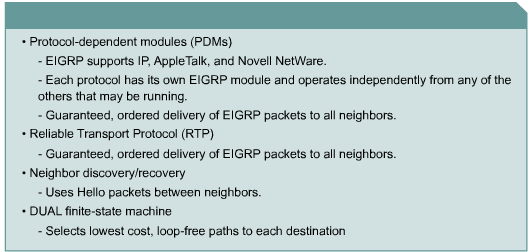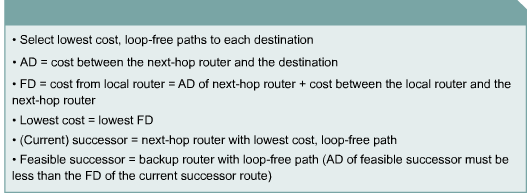Difference between revisions of "Bjeff CCNP 1"
(→Enable OSPF and Loopback) |
|||
| Line 73: | Line 73: | ||
router ospf 1 | router ospf 1 | ||
network 172.16.100.16 0.0.0.3 area 11 | network 172.16.100.16 0.0.0.3 area 11 | ||
| + | network 192.168.16.0 0.0.0.255 area 11 | ||
| + | network 192.168.17.0 0.0.0.255 area 11 | ||
| + | network 192.168.18.0 0.0.0.255 area 11 | ||
| + | network 192.168.19.0 0.0.0.255 area 11 | ||
interface Loopback 0 | interface Loopback 0 | ||
Revision as of 13:16, 11 February 2009
Contents
- 1 CCNP 1
- 1.1 Forkortelser
- 1.2 2.1 EIGRP Fundamentals and Features
- 1.3 2.2 EIGRP Components and Operation
- 1.4 2.3 Implementing and Verifying EIGRP
- 1.5 2.4 Implementing Advanced EIGRP Features
- 1.6 2.5 Configuring EIGRP Authentication
- 1.7 2.6 Using EIGRP in the Enterprise
- 1.8 2.7 EIGRP Lab Exercises
- 1.9 Enable OSPF and Loopback
CCNP 1
Forkortelser
- Enhanced Interior Gateway Routing Protocol (EIGRP) is a Cisco-proprietary routing protocol.
- Protocol-dependent modules (PDMs) are responsible for network layer protocol-specific requirements.
- Reliable Transport Protocol (RTP is responsible for guaranteed ordered delivery and reception of EIGRP packets to all neighbors.
- advertised distance (AD)
- feasible distance (FD)
- Routing Information Protocol (RIP)
- classless interdomain routing (CIDR)
- variable length subnet masking (VLSM)
- Open Shortest Path First (OSPF)
2.1 EIGRP Fundamentals and Features
Fast convergence
A router running EIGRP stores all its neighbors’ routing tables so that it can quickly adapt to alternate routes if a preferred route disappears. If an appropriate route does not exist, EIGRP queries its neighbors to discover an alternate route. These queries propagate until an alternate route is found.
VLSM support
EIGRP is a classless routing protocol, which means that it advertises a subnet mask for each destination network. Support for VLSM allows for different subnetmasks within the same network and support for non-contiguous subnetworks. EIGRP routes are automatically summarized at the major network number boundary. However, EIGRP can be configured to summarize on any bit boundary on any router interface.
Partial updates
EIGRP does not send periodic updates. Instead, it sends partial triggered updates. The updates are sent only when the path or the metric changes for a route, and they contain only information about the changed routes. Propagation of partial updates is automatically bounded so that only those routers that need the information are updated. Partial updates are handled by using multicast and unicast packets instead of broadcast packets. As a result, EIGRP consumes significantly less bandwidth than IGRP. This behavior is different than link-state protocols, in which an update is transmitted to all link-state routers within an area.
Multiple network-layer protocol support
EIGRP supports IP, AppleTalk, and Novell NetWare IPX through the use of protocol-dependent modules. These modules are responsible for protocol requirements specific to the network layer. The rapid convergence and sophisticated metric structure of EIGRP offers superior performance and stability when implemented in IPX and AppleTalk networks.
Multicast and unicast
To establish neighbor relationships, EIGRP uses multicast and unicast addressing rather than broadcast addressing to send and acknowledge routing updates. The EIGRP multicast address is 224.0.0.10. The use of multicast and unicast also helps reduce bandwidth requirements.
Underlying Process and Technologies
Successor
A successor, also called a current successor, is a neighboring router that has a least cost path to a destination (the lowest FD) that is guaranteed not to be part of a routing loop. Successors are used for forwarding packets. Every destination for which one or more feasible successors exists is recorded in a topology table. For every destination listed in the topology table, the route with the lowest metric is chosen and placed in the routing table.
Multiple successors can exist if they have the same FD. By default, four successors can be added to the routing table. However, the router can be configured to accept up to six per destination.
DUAL also keeps backup paths to each destination. The next-hop router for a backup path is called the feasible successor. To qualify as a feasible successor, a next-hop router must have an AD less than the FD of the current successor route
2.2 EIGRP Components and Operation
Metric
- Although the metric can be based on five criteria:
- Bandwidth: Smallest bandwidth between source and destination.
- Delay: Cumulative interface delay along the path.
- Reliability: Worst reliability between source and destination, based on keepalives.
- Loading: Worst load on a link between source and destination, based on the packet rate and the configured bandwidth of the interface.
- MTU: Smallest MTU in the path. MTU is included in the EIGRP routing update, but is not actually used in the metric calculation.
2.3 Implementing and Verifying EIGRP
2.4 Implementing Advanced EIGRP Features
2.5 Configuring EIGRP Authentication
2.6 Using EIGRP in the Enterprise
2.7 EIGRP Lab Exercises
Enable OSPF and Loopback
router ospf 1
network 172.16.100.16 0.0.0.3 area 11 network 192.168.16.0 0.0.0.255 area 11 network 192.168.17.0 0.0.0.255 area 11 network 192.168.18.0 0.0.0.255 area 11 network 192.168.19.0 0.0.0.255 area 11
interface Loopback 0
ip address 10.0.0.4 255.255.255.255
interface Loopback 1
ip address 192.168.16.1 255.255.255.0
interface Loopback 2
ip address 192.168.17.1 255.255.255.0
interface Loopback 3
ip address 192.168.18.1 255.255.255.0
interface Loopback 4
ip address 192.168.19.1 255.255.255.0

